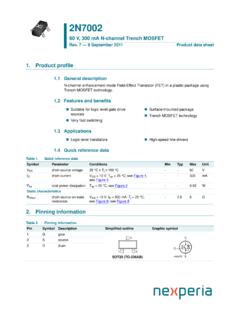Transcription of Position Statement for Management of Genitourinary ...
1 Position Statement for Management of Genitourinary Syndrome of the Menopause (GSM) Dr Louise Newson BSc (Hons) MBChB (Hons) MRCP FRCGP, Professor Mike Kirby MB BS LRCP MRCS MRCP FRCP, Dr Susan Stillwell MBChB FRCOG FFSRH DCH, Professor Geoff Hackett MD FRCP (I) MRCGP FECSM, Dr Sarah Ball MBChB MRCGP DCH DRCOG DFFP, Dr Rebecca Lewis MBBS FRCA DRCOG MRCGPOne of the most consistently identified predictors of impaired sexual health in women is the presence of vaginal symptoms. The vast majority of postmenopausal women have symptoms associated with Genitourinary Syndrome of the Menopause (GSM) yet only a minority receive any treatment.
2 Unlike many other symptoms of the menopause, symptoms of GSM often worsen over time. This guidance is designed to support healthcare professionals in diagnosing and managing this condition. Terminology The term Genitourinary Syndrome of Menopause (GSM) was introduced in 2014. GSM is a comprehensive term that includes vulvovaginal symptoms and lower urinary tract symptoms related to low oestrogen levels. The terms vulvovaginal atrophy and atrophic vaginitis (which were in general use) had a limitation because they did not cover the full spectrum of symptoms and did not indicate that symptoms were directly related to decreased oestrogen levels in the menopausal state.
3 GSM more accurately describes the postmenopausal hypoestrogenic state of the Genitourinary Talking about GSM GSM is very common but often underdiagnosed and undertreated. Studies have shown that around 70% of women have symptoms of GSM, yet only 7% receive Despite a vast majority of women experiencing symptoms related to this condition, only around 25% of women volunteer this information to their healthcare professional. 70% of healthcare professionals acknowledge they never, or rarely, ask about problems like vaginal dryness2. The prevailing attitude among both women and healthcare professionals is one that considers symptoms of GSM to be a natural and unavoidable part of the aging NICE menopause guidance gives clear recommendations regarding the optimal Management of this condition in menopausal and postmenopausal Treatments for GSM are usually effective, safe and cost Women need to receive individualised advice and treatment for this debilitating condition as a priority.
4 Symptoms and Signs The symptoms and signs of GSM are detailed in Figure 1. Impact of GSM GSM leads many women to needlessly suffer with unbearable symptoms. It can affect women of all ages and is not solely related to the menopause. Low oestrogen states also exist in women who are breast feeding or women using progestogen-only contraceptives. Symptoms associated with GSM can have a very negative effect on interpersonal relationships, quality of life and daily Oestrogen receptors are present in the vagina, urethra, bladder trigone and pelvic floor. All these areas can be affected by a lack of oestrogen during the perimenopause and A fall in oestrogen can result in the loss of superficial epithelial cells, collagen and elastin, resulting in loss of vaginal The vaginal epithelium becomes pale and friable and can tear and bleed, particularly during intercourse.
5 Atrophy of the urethra, with a relative increase in urethral epithelial transitional cells and a corresponding decrease in intermediate and superficial squamous cells occurs after The smooth muscle in the lower urogenital tract atrophies, affecting the superficial muscle layers of the trigone, the proximal and distal urethra, and the lamina propria of the trigone and proximal SymptomsSignsGenital dryness Decreased lubrication during sexual activity Discomfort or pain during sexual activity Post-coital bleeding Decreased arousal, orgasm, desire Irritation, burning, or itching of the vulva or vagina Urinary frequency and urgencyDecreased moisture Decreased elasticity Labia minora resorption Pallor, erythema Loss of vaginal rugae Tissue fragility, fissures, petechiae Urethral eversion or prolapse Prominence of urethral meatus Introital retraction Recurrent urinary tract infectionsFigure 1.
6 Symptoms and Signs of GSM1 These symptoms are reported to affect self esteem and reduce QOL, including in women who are not sexually Women who have received chemotherapy, surgery, and/or radiotherapy for certain types of malignancies have a higher risk of developing Other conditions, such as inflammatory bowel disease, diabetes mellitus, multiple sclerosis and stress can be associated with vaginal In addition, some medications, such as tamoxifen, antihistamines, decongestants and some antidepressants can also cause Understanding the history Women need to be asked the appropriate questions during consultations for the diagnosis of GSM to be made.
7 If the right questions are asked, in the right clinical setting, women are more likely to be open about their symptoms. Questions need to be asked in a sensitive manner and women should be given time to reflect and talk about this problem which, understandably, can be very embarrassing and awkward to discuss. Menopausal women who present with urinary symptoms such as increased urinary frequency, urgency or recurrent urinary tract infections should also be asked if they experience any local vaginal symptoms. Although pain and discomfort may be present during sexual intercourse, many women find they experience symptoms at other times, for example when they are walking, cycling, horse riding or simply just sitting It is also important to gain an understanding of whether the patient is likely to be at risk of a sexually transmitted infection by asking appropriate questions.
8 All postmenopausal women should be asked about any symptoms regardless of their Nurses undertaking cervical screening are well placed to enquire about any symptoms as are all healthcare professionals who see postmenopausal women as part of their clinical work. Many women avoid having cervical screening because a speculum examination is too painful in view of their untreated and vaginal dryness discharge itching dyspareunia urinary frequency and urgency dysuria nocturia recurrent UTIs2,10 As a result of these changes, women can experience symptoms of: Does it feel different in any way around your vulva or vaginal area?
9 Have you noticed any vaginal dryness or less discharge than you used to have? Have you experienced any vaginal soreness, burning or irritation? Do you have any itching around your vagina or vulval area? Is sexual intercourse painful or uncomfortable? Have you noticed changes in any vaginal discharge (either increased or reduced)? Have you noticed any symptoms such as increased urinary frequency or being less able to hold on to urine? Do you have any discomfort on passing urine? Useful questions to ask:Examination The decision regarding examination of women with GSM should be individualised and often depends on the clinical setting.
10 Treatment does not need to be delayed if an examination is not possible during the initial consultation, for example a remote consultation. Women should be offered an examination and their decision to accept it or not needs to be respected. Examination should be considered if there are symptoms in a woman s history to suggest any other underlying pathology or if clinically indicated. Some women may prefer to share a digital image rather than having an examination undertaken. In addition, a genital examination should be undertaken if: symptoms do not improve symptoms worsen after an initial treatment period of at least three months symptoms change or worsen before this time On examination, you may see: atrophy of the vulva and vagina thinning of vaginal epithelium with loss of rugae and elasticity paler vaginal epithelium due to reduced blood supply in this area petechial haemorrhages Physical appearance does not usually correlate with severity of symptoms.








